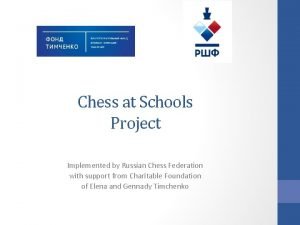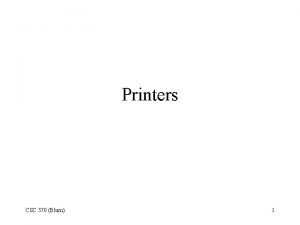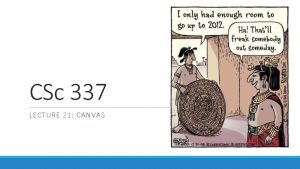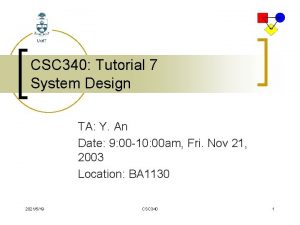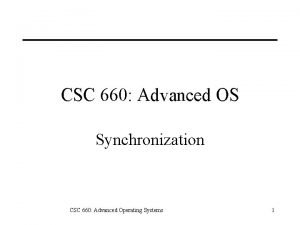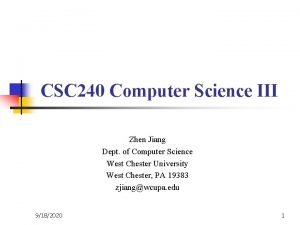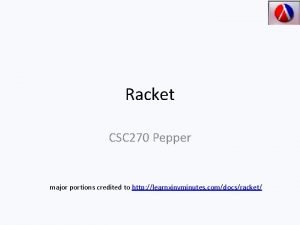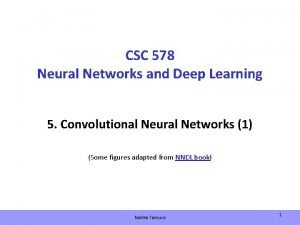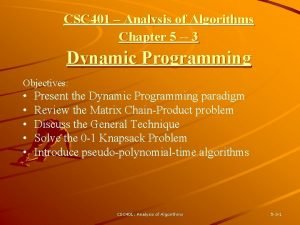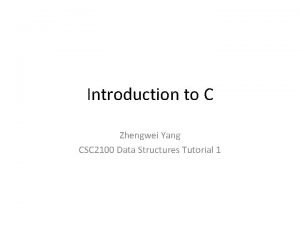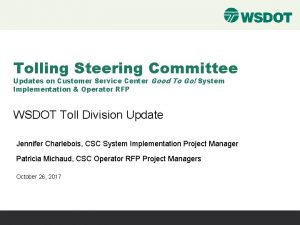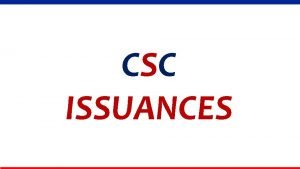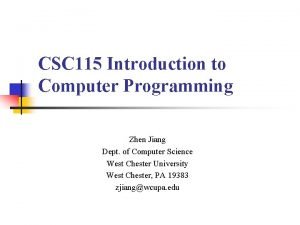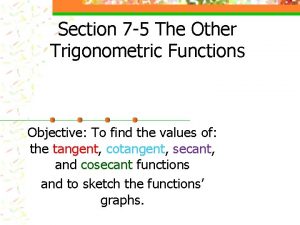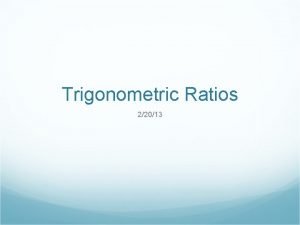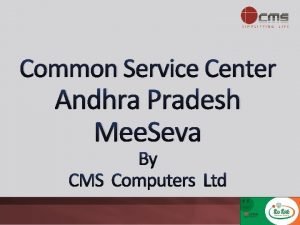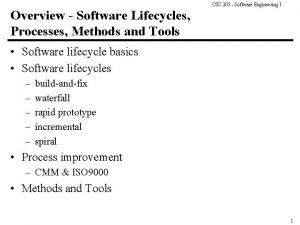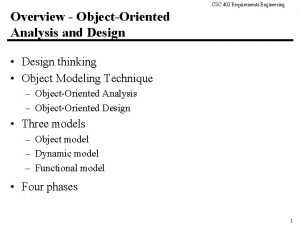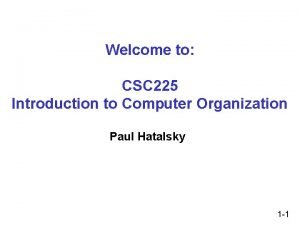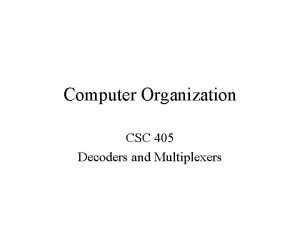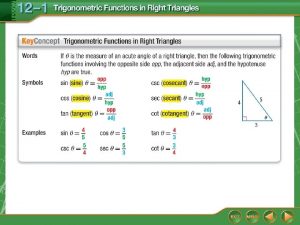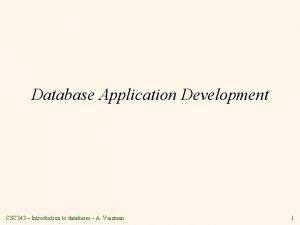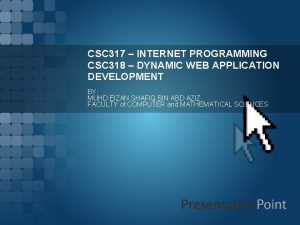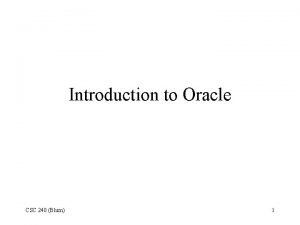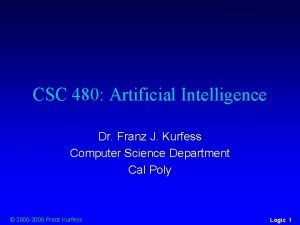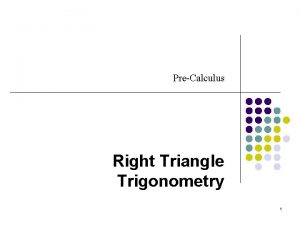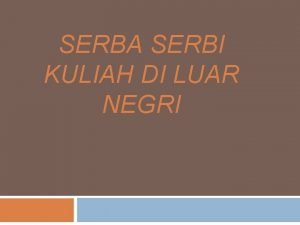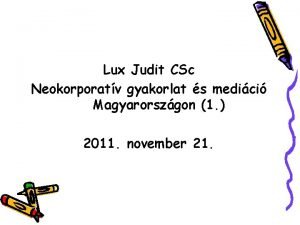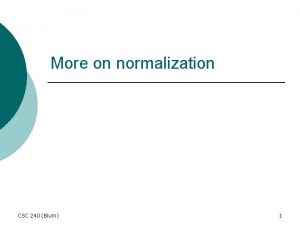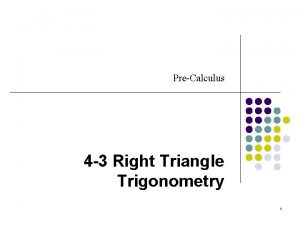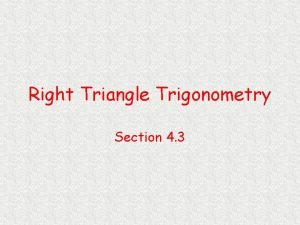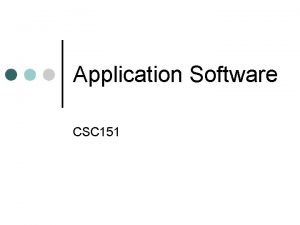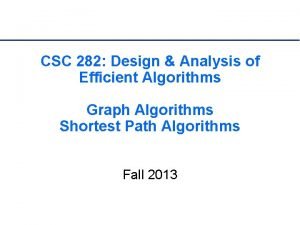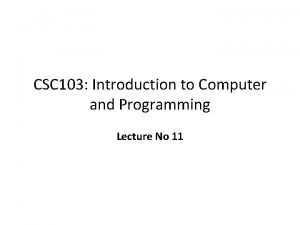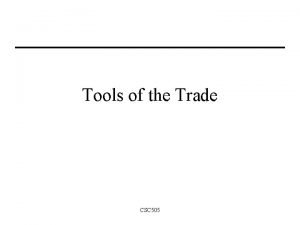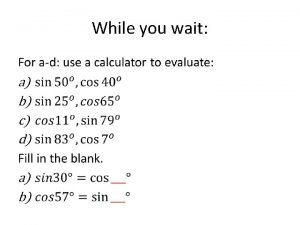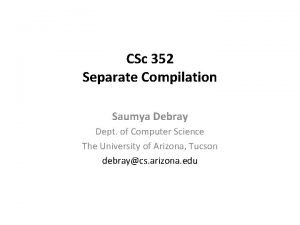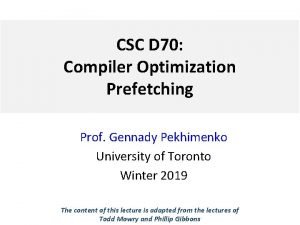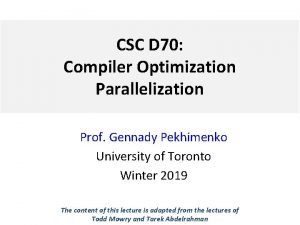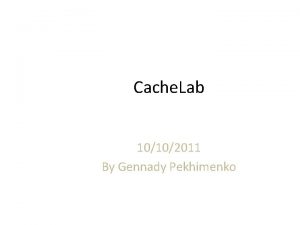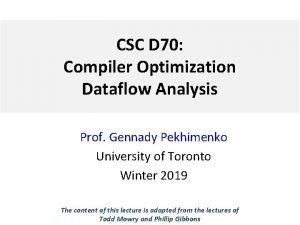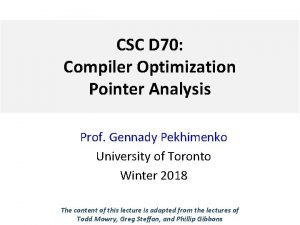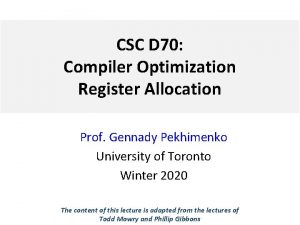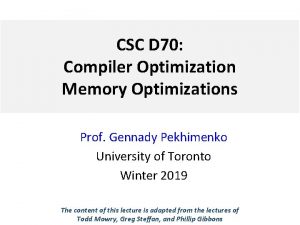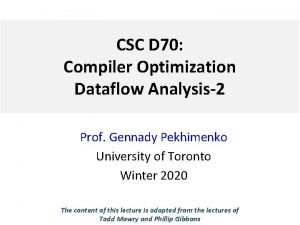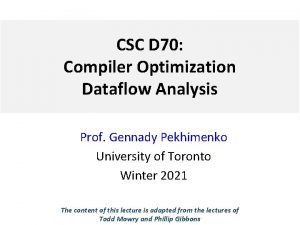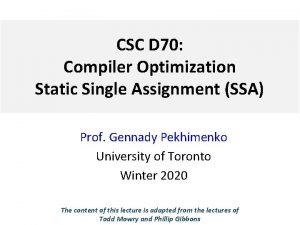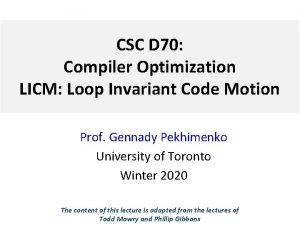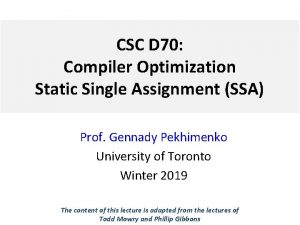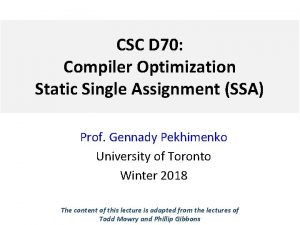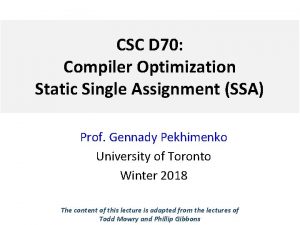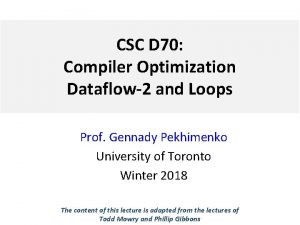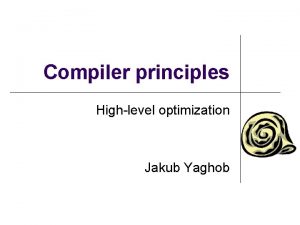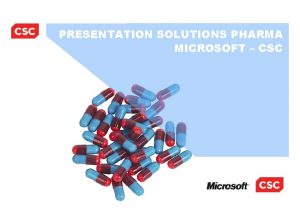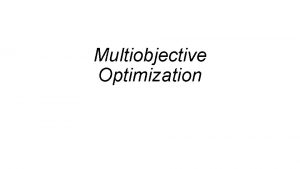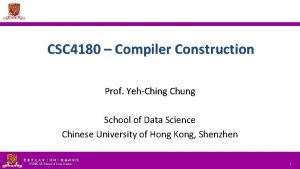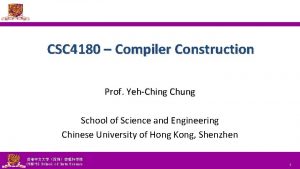CSC D 70 Compiler Optimization Prof Gennady Pekhimenko

















































- Slides: 49

CSC D 70: Compiler Optimization Prof. Gennady Pekhimenko University of Toronto Winter 2018 The content of this lecture is adapted from the lectures of Todd Mowry and Phillip Gibbons

CSC D 70: Compiler Optimization Introduction, Logistics Prof. Gennady Pekhimenko University of Toronto Winter 2018 The content of this lecture is adapted from the lectures of Todd Mowry and Phillip Gibbons

Summary • Syllabus – Course Introduction, Logistics, Grading • Information Sheet – Getting to know each other • Assignments • Learning LLVM • Compiler Basics 3

Syllabus: Who Are We? 4

Gennady (Gena) Pekhimenko Assistant Professor, Instructor pekhimenko@cs. toronto. edu http: //www. cs. toronto. edu/~pekhimenko/ Office: BA 5232 / IC 454 Ph. D from Carnegie Mellon Worked at Microsoft Research, NVIDIA, IBM Research interests: computer architecture, systems, machine learning, compilers, hardware acceleration, bioinformatics Computer Systems and Networking Group (CSNG) Eco. System Group

Bojian Zheng MSc. Student, TA bojian@cs. toronto. edu Office: BA 5214 D 02 BSc. from Uof. T ECE Research interests: computer architecture, GPUs, machine learning Computer Systems and Networking Group (CSNG) Eco. System Group

Course Information: Where to Get? • Course Website: http: //www. cs. toronto. edu/~pekhimenko/courses/cscd 70 w 18/ – Announcements, Syllabus, Course Info, Lecture Notes, Tutorial Notes, Assignments • Piazza: https: //piazza. com/utoronto. ca/winter 2018/cscd 70/home – Questions/Discussions, Syllabus, Announcements • Blackboard – Emails/announcements • Your email 7

Useful Textbook 8

CSC D 70: Compiler Optimization Compiler Introduction Prof. Gennady Pekhimenko University of Toronto Winter 2018 The content of this lecture is adapted from the lectures of Todd Mowry and Phillip Gibbons

Introduction to Compilers • What would you get out of this course? • Structure of a Compiler • Optimization Example 10

What Do Compilers Do? 1. Translate one language into another – e. g. , convert C++ into x 86 object code – difficult for “natural” languages, but feasible for computer languages 2. Improve (i. e. “optimize”) the code – e. g. , make the code run 3 times faster • or more energy efficient, more robust, etc. – driving force behind modern processor design 11

How Can the Compiler Improve Performance? Execution time = Operation count * Machine cycles per operation • Minimize the number of operations – arithmetic operations, memory accesses • Replace expensive operations with simpler ones – e. g. , replace 4 -cycle multiplication with 1 -cycle shift • Minimize cache misses – both data and instruction accesses • Perform work in parallel – instruction scheduling within a thread – parallel execution across multiple threads 12

What Would You Get Out of This Course? • Basic knowledge of existing compiler optimizations • Hands-on experience in constructing optimizations within a fully functional research compiler • Basic principles and theory for the development of new optimizations 13

Structure of a Compiler x 86 ARM SPARC MIPS • Optimizations are performed on an “intermediate form” – similar to a generic RISC instruction set • Allows easy portability to multiple source languages, target machines 14

Ingredients in a Compiler Optimization • Formulate optimization problem – Identify opportunities of optimization • applicable across many programs • affect key parts of the program (loops/recursions) • amenable to “efficient enough” algorithm • Representation – Must abstract essential details relevant to optimization 15

Ingredients in a Compiler Optimization 16

Ingredients in a Compiler Optimization • Formulate optimization problem – Identify opportunities of optimization • applicable across many programs • affect key parts of the program (loops/recursions) • amenable to “efficient enough” algorithm • Representation – Must abstract essential details relevant to optimization • Analysis – Detect when it is desirable and safe to apply transformation • Code Transformation • Experimental Evaluation (and repeat process) 17

Representation: Instructions • Three-address code A : = B op C • LHS: name of variable e. g. x, A[t] (address of A + contents of t) • RHS: value • Typical instructions A : = B op C A : = unaryop B A : = B GOTO s IF A relop B GOTO s CALL f RETURN 18

Optimization Example • Bubblesort program that sorts an array A that is allocated in static storage: – an element of A requires four bytes of a byte-addressed machine – elements of A are numbered 1 through n (n is a variable) – A[j] is in location &A+4*(j-1) FOR i : = n-1 DOWNTO 1 DO FOR j : = 1 TO i DO IF A[j]> A[j+1] THEN BEGIN temp : = A[j]; A[j] : = A[j+1]; A[j+1] : = temp END 19

Translated Code S 5: s 4: i : = n-1 if i<1 goto s 1 j : = 1 if j>i goto s 2 t 1 : = j-1 t 2 : = 4*t 1 t 3 : = A[t 2] ; A[j] t 4 : = j+1 t 5 : = t 4 -1 t 6 : = 4*t 5 t 7 : = A[t 6] ; A[j+1] if t 3<=t 7 goto s 3 FOR i : = n-1 DOWNTO 1 DO FOR j : = 1 TO i DO IF A[j]> A[j+1] THEN BEGIN temp : = A[j]; A[j] : = A[j+1]; A[j+1] : = temp END t 8 : =j-1 t 9 : = 4*t 8 temp : = A[t 9] ; A[j] t 10 : = j+1 t 11: = t 10 -1 t 12 : = 4*t 11 t 13 : = A[t 12] ; A[j+1] t 14 : = j-1 t 15 : = 4*t 14 A[t 15] : = t 13 ; A[j]: =A[j+1] t 16 : = j+1 t 17 : = t 16 -1 t 18 : = 4*t 17 A[t 18]: =temp ; A[j+1]: =temp s 3: j : = j+1 goto S 4 S 2: i : = i-1 goto s 5 s 1: 20

Representation: a Basic Block • Basic block = a sequence of 3 -address statements – only the first statement can be reached from outside the block (no branches into middle of block) – all the statements are executed consecutively if the first one is (no branches out or halts except perhaps at end of block) • We require basic blocks to be maximal – they cannot be made larger without violating the conditions • Optimizations within a basic block are local optimizations 21

Flow Graphs • Nodes: basic blocks • Edges: Bi -> Bj, iff Bj can follow Bi immediately in some execution – Either first instruction of Bj is target of a goto at end of Bi – Or, Bj physically follows Bi, which does not end in an unconditional goto. • The block led by first statement of the program is the start, or entry node. 22

Find the Basic Blocks S 5: s 4: i : = n-1 if i<1 goto s 1 j : = 1 if j>i goto s 2 t 1 : = j-1 t 2 : = 4*t 1 t 3 : = A[t 2] ; A[j] t 4 : = j+1 t 5 : = t 4 -1 t 6 : = 4*t 5 t 7 : = A[t 6] ; A[j+1] if t 3<=t 7 goto s 3 t 8 : =j-1 t 9 : = 4*t 8 temp : = A[t 9] ; A[j] t 10 : = j+1 t 11: = t 10 -1 t 12 : = 4*t 11 t 13 : = A[t 12] ; A[j+1] t 14 : = j-1 t 15 : = 4*t 14 A[t 15] : = t 13 ; A[j]: =A[j+1] t 16 : = j+1 t 17 : = t 16 -1 t 18 : = 4*t 17 A[t 18]: =temp ; A[j+1]: =temp s 3: j : = j+1 goto S 4 S 2: i : = i-1 goto s 5 s 1: 23

Basic Blocks from Example 24

Partitioning into Basic Blocks • Identify the leader of each basic block – First instruction – Any target of a jump – Any instruction immediately following a jump • Basic block starts at leader & ends at instruction immediately before a leader (or the last instruction) 25

ALSU pp. 529 -531 26

Sources of Optimizations • Algorithm optimization • Algebraic optimization A : = B+0 => A : = B • Local optimizations – within a basic block -- across instructions • Global optimizations – within a flow graph -- across basic blocks • Interprocedural analysis – within a program -- across procedures (flow graphs) 27

Local Optimizations • Analysis & transformation performed within a basic block • No control flow information is considered • Examples of local optimizations: – local common subexpression elimination analysis: same expression evaluated more than once in b. transformation: replace with single calculation – local constant folding or elimination analysis: expression can be evaluated at compile time transformation: replace by constant, compile-time value – dead code elimination 28

Example S 5: s 4: i : = n-1 if i<1 goto s 1 j : = 1 if j>i goto s 2 t 1 : = j-1 t 2 : = 4*t 1 t 3 : = A[t 2] ; A[j] t 4 : = j+1 t 5 : = t 4 -1 t 6 : = 4*t 5 t 7 : = A[t 6] ; A[j+1] if t 3<=t 7 goto s 3 t 8 : =j-1 t 9 : = 4*t 8 temp : = A[t 9] ; A[j] t 10 : = j+1 t 11: = t 10 -1 t 12 : = 4*t 11 t 13 : = A[t 12] ; A[j+1] t 14 : = j-1 t 15 : = 4*t 14 A[t 15] : = t 13 ; A[j]: =A[j+1] t 16 : = j+1 t 17 : = t 16 -1 t 18 : = 4*t 17 A[t 18]: =temp ; A[j+1]: =temp s 3: j : = j+1 goto S 4 S 2: i : = i-1 goto s 5 s 1: 29

Example B 1: B 2: B 3: B 4: B 6: i : = n-1 if i<1 goto out j : = 1 if j>i goto B 5 t 1 : = j-1 t 2 : = 4*t 1 t 3 : = A[t 2] ; A[j] t 6 : = 4*j t 7 : = A[t 6] ; A[j+1] if t 3<=t 7 goto B 8 B 7: t 8 : =j-1 t 9 : = 4*t 8 temp : = A[t 9] t 12 : = 4*j t 13 : = A[t 12] A[t 9]: = t 13 A[t 12]: =temp B 8: j : = j+1 goto B 4 B 5: i : = i-1 goto B 2 out: ; temp: =A[j] ; A[j+1] ; A[j]: =A[j+1] ; A[j+1]: =temp 30

(Intraprocedural) Global Optimizations • Global versions of local optimizations – global common subexpression elimination – global constant propagation – dead code elimination • Loop optimizations – reduce code to be executed in each iteration – code motion – induction variable elimination • Other control structures – Code hoisting: eliminates copies of identical code on parallel paths in a flow graph to reduce code size. 31

Example B 1: B 2: B 3: B 4: B 6: i : = n-1 if i<1 goto out j : = 1 if j>i goto B 5 t 1 : = j-1 t 2 : = 4*t 1 t 3 : = A[t 2] ; A[j] t 6 : = 4*j t 7 : = A[t 6] ; A[j+1] if t 3<=t 7 goto B 8 B 7: t 8 : =j-1 t 9 : = 4*t 8 temp : = A[t 9] t 12 : = 4*j t 13 : = A[t 12] A[t 9]: = t 13 A[t 12]: =temp B 8: j : = j+1 goto B 4 B 5: i : = i-1 goto B 2 out: ; temp: =A[j] ; A[j+1] ; A[j]: =A[j+1] ; A[j+1]: =temp 32

Example (After Global CSE) B 1: B 2: B 3: B 4: B 6: i : = n-1 if i<1 goto out j : = 1 if j>i goto B 5 t 1 : = j-1 t 2 : = 4*t 1 t 3 : = A[t 2] ; A[j] t 6 : = 4*j t 7 : = A[t 6] ; A[j+1] if t 3<=t 7 goto B 8 B 7: A[t 2] : = t 7 A[t 6] : = t 3 B 8: j : = j+1 goto B 4 B 5: i : = i-1 goto B 2 out: 33

Induction Variable Elimination • Intuitively – Loop indices are induction variables (counting iterations) – Linear functions of the loop indices are also induction variables (for accessing arrays) • Analysis: detection of induction variable • Optimizations – strength reduction: • replace multiplication by additions – elimination of loop index: • replace termination by tests on other induction variables 34

Example B 1: B 2: B 3: B 4: B 6: i : = n-1 if i<1 goto out j : = 1 if j>i goto B 5 t 1 : = j-1 t 2 : = 4*t 1 t 3 : = A[t 2] ; A[j] t 6 : = 4*j t 7 : = A[t 6] ; A[j+1] if t 3<=t 7 goto B 8 B 7: A[t 2] : = t 7 A[t 6] : = t 3 B 8: j : = j+1 goto B 4 B 5: i : = i-1 goto B 2 out: 35

Example (After IV Elimination) B 1: B 2: B 3: B 4: B 6: i : = n-1 if i<1 goto out t 2 : = 0 t 6 : = 4 t 19 : = 4*I if t 6>t 19 goto B 5 t 3 : = A[t 2] t 7 : = A[t 6] ; A[j+1] if t 3<=t 7 goto B 8 B 7: B 8: B 5: A[t 2] : = t 7 A[t 6] : = t 3 t 2 : = t 2+4 t 6 : = t 6+4 goto B 4 i : = i-1 goto B 2 out: 36

Loop Invariant Code Motion • Analysis – a computation is done within a loop and – result of the computation is the same as long as we keep going around the loop • Transformation – move the computation outside the loop 37

Machine Dependent Optimizations • • Register allocation Instruction scheduling Memory hierarchy optimizations etc. 38

Local Optimizations (More Details) • Common subexpression elimination – array expressions – field access in records – access to parameters 39

Graph Abstractions Example 1: • grammar (for bottom-up parsing): E -> E + T | E – T | T, T -> T*F | F, F -> ( E ) | id • expression: a+a*(b-c)+(b-c)*d 40

Graph Abstractions Example 1: an expression a+a*(b-c)+(b-c)*d Optimized code: t 1 = b - c t 2 = a * t 1 t 3 = a + t 2 t 4 = t 1 * d t 5 = t 3 + t 4 41

How well do DAGs hold up across statements? • Example 2 a b c d = = b+c; a-d; Is this optimized code correct? a = b+c; d = a-d; c = d+c; 42

Critique of DAGs • Cause of problems – Assignment statements – Value of variable depends on TIME • How to fix problem? – build graph in order of execution – attach variable name to latest value • Final graph created is not very interesting – Key: variable->value mapping across time – loses appeal of abstraction 43

Value Number: Another Abstraction • More explicit with respect to VALUES, and TIME • each value has its own “number” – common subexpression means same value number • var 2 value: current map of variable to value – used to determine the value number of current expression r 1 + r 2 => var 2 value(r 1)+var 2 value(r 2) 44

Algorithm Data structure: VALUES = Table of expression //[OP, valnum 1, valnum 2} var //name of variable currently holding expression For each instruction (dst = src 1 OP src 2) in execution order valnum 1 = var 2 value(src 1); valnum 2 = var 2 value(src 2); IF [OP, valnum 1, valnum 2] is in VALUES v = the index of expression Replace instruction with CPY dst = VALUES[v]. var ELSE Add expression = [OP, valnum 1, valnum 2] var = dst to VALUES v = index of new entry; tv is new temporary for v Replace instruction with: tv = VALUES[valnum 1]. var OP VALUES[valnum 2]. var dst = tv; set_var 2 value (dst, v) 45

More Details • What are the initial values of the variables? – values at beginning of the basic block • Possible implementations: – Initialization: create “initial values” for all variables – Or dynamically create them as they are used • Implementation of VALUES and var 2 value: hash tables 46

Example Assign: a->r 1, b->r 2, c->r 3, d->r 4 a = b+c; ADD t 1 = r 2, r 3 CPY r 1 = t 1 b = a-d; SUB t 2 = r 1, r 4 CPY r 2 = t 2 c = b+c; ADD t 3 = r 2, r 3 CPY r 3 = t 3 d = a-d; SUB t 4 = r 1, r 4 CPY r 4 = t 4 47

Conclusions • Comparisons of two abstractions – DAGs – Value numbering • Value numbering – VALUE: distinguish between variables and VALUES – TIME • Interpretation of instructions in order of execution • Keep dynamic state information 48

CSC D 70: Compiler Optimization Introduction, Logistics Prof. Gennady Pekhimenko University of Toronto Winter 2018 The content of this lecture is adapted from the lectures of Todd Mowry and Phillip Gibbons
 Gennady timchenko elena timchenko
Gennady timchenko elena timchenko Machine independent loader features
Machine independent loader features Cross compiler in compiler design
Cross compiler in compiler design Yacc tutorial
Yacc tutorial Sohcahtoa secant
Sohcahtoa secant Csc ncsu
Csc ncsu Said kerrache
Said kerrache Csc 370
Csc 370 Csc a
Csc a Canvas csc
Canvas csc Csc 340
Csc 340 Csc 660
Csc 660 Csc(240)
Csc(240) Csc 253
Csc 253 Csc 270
Csc 270 Csc
Csc Csc 578
Csc 578 Csc 401
Csc 401 Csc.weebly
Csc.weebly Usa*csc tep co
Usa*csc tep co Csc
Csc Wsdot-goodtogo csc
Wsdot-goodtogo csc Cs form no. 33-b revised 2018
Cs form no. 33-b revised 2018 Csc 115
Csc 115 Csc skill center banner
Csc skill center banner Sec csc cot
Sec csc cot Trig ratio
Trig ratio Cms csc ap
Cms csc ap Csc 205
Csc 205 Csc402
Csc402 Csc(225)
Csc(225) Csc 405
Csc 405 Csc a
Csc a Csc 343
Csc 343 Csc 317
Csc 317 Populiso
Populiso Csc 240°
Csc 240° Csc 480 degrees
Csc 480 degrees Sin cos tan csc sec cot
Sin cos tan csc sec cot Keuntungan kuliah di china
Keuntungan kuliah di china Csc jelentése
Csc jelentése Csc 240 degrees
Csc 240 degrees Sin cos tan csc sec cot
Sin cos tan csc sec cot Hypothnus
Hypothnus A software consists of
A software consists of Path finding
Path finding Csc 103
Csc 103 Csc 505
Csc 505 Tanx identity
Tanx identity Saumya debray
Saumya debray
